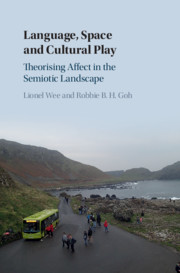Book contents
- Language, Space, and Cultural Play
- Language, Space, and Cultural Play
- Copyright page
- Contents
- Figures
- Acknowledgments
- 1 Introduction
- 2 Theorizing Affect in the Semiotic Landscape
- 3 Kawaii in the Semiotic Landscape
- 4 Reverencing the Landscape
- 5 Romancing the Landscape
- 6 “Friendly Places”
- 7 The Affective Regime of Luxury and Exclusivity
- 8 Affecting the Digital Landscape
- 9 Conclusion
- References
- Index
3 - Kawaii in the Semiotic Landscape
Published online by Cambridge University Press: 30 October 2019
- Language, Space, and Cultural Play
- Language, Space, and Cultural Play
- Copyright page
- Contents
- Figures
- Acknowledgments
- 1 Introduction
- 2 Theorizing Affect in the Semiotic Landscape
- 3 Kawaii in the Semiotic Landscape
- 4 Reverencing the Landscape
- 5 Romancing the Landscape
- 6 “Friendly Places”
- 7 The Affective Regime of Luxury and Exclusivity
- 8 Affecting the Digital Landscape
- 9 Conclusion
- References
- Index
Summary
Chapter 3 illustrates what might be considered a relatively transparent attempt at regulating affect: the use of figures that are considered kawaii, a Japanese term meaning ‘cute’ or ‘adorable’. An examination of how kawaii figures are employed by various municipal authorities in Tokyo brings to light just how affect works when linguistic and non-linguistic modalities are combined. The use of kawaii in public signage, especially in the form of cartoon figures, brings to light and helps exemplify Ahmed’s (2004a, b) claim that affect circulates via the use of characters that tend to evoke specific cultural stereotypes.
- Type
- Chapter
- Information
- Language, Space and Cultural PlayTheorising Affect in the Semiotic Landscape, pp. 34 - 53Publisher: Cambridge University PressPrint publication year: 2019

